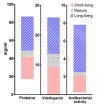The Year of the Honey Bee (Apis mellifera L.) with Respect to Its Physiology and Immunity: A Search for Biochemical Markers of Longevity
- PMID: 31394797
- PMCID: PMC6723739
- DOI: 10.3390/insects10080244
The Year of the Honey Bee (Apis mellifera L.) with Respect to Its Physiology and Immunity: A Search for Biochemical Markers of Longevity
Abstract
It has been known for many years that in temperate climates the European honey bee, Apis mellifera, exists in the form of two distinct populations within the year, short-living summer bees and long-living winter bees. However, there is only limited knowledge about the basic biochemical markers of winter and summer populations as yet. Nevertheless, the distinction between these two kinds of bees is becoming increasingly important as it can help beekeepers to estimate proportion of long-living bees in hives and therefore in part predict success of overwintering. To identify markers of winter generations, we employed the continuous long-term monitoring of a single honey bee colony for almost two years, which included measurements of physiological and immunological parameters. The results showed that the total concentration of proteins, the level of vitellogenin, and the antibacterial activity of haemolymph are the best three of all followed parameters that are related to honey bee longevity and can therefore be used as its markers.
Keywords: honey bee; immunity; longevity; physiology; seasonal changes.
Conflict of interest statement
The authors declare no conflicts of interest. The funders had no role in the design of the study; in the collection, analyses, or interpretation of data; in the writing of the manuscript, or in the decision to publish the results.
Figures







References
Grants and funding
LinkOut - more resources
Full Text Sources
Molecular Biology Databases

